AEG LAV86720, LAV 86720-W Manual
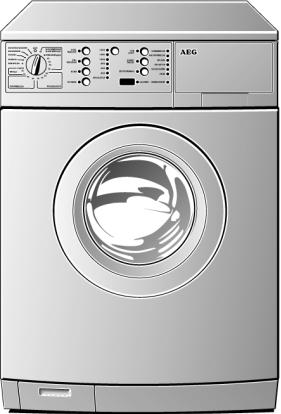
ÖKO-LAVAMAT 86720 update
The environmentally friendly washing machine
Instruction book

|
Dear customer, |
|
Please read these user instructions carefully. |
|
Above all, observe the "Safety" section in the first pages. Keep these |
|
user instructions in a safe place for future reference. Please pass them |
|
along to future owners of the appliance. |
1 |
Important information concerning your safety and proper functioning |
|
of the appliance is highlighted with the warning triangle or the signal |
|
words (Warning!, Caution!, Attention!). Please observe carefully. |
0 1. |
This symbol guides you step by step when operating the appliance. |
2. ... |
|
3 |
Next to this symbol you receive additional information and practical |
|
tips on using the appliance. |
2 |
Tips and information about the economical and environmentally |
|
friendly use of the machine are marked with the clover. |
These user instructions include tips for the correction of possible malfunctions by the user. See the section "What to do when...".
Our customer service department is at your disposal should technical problems occur. See also the "Service" section.
Printed on paper manufactured with environmentally sound processes.
He who thinks ecologically acts accordingly ...
2

|
Contents |
CONTENTS |
|
Operating instructions . . . . . . . . . . . . . . . . . . . . . . . . . . . . . . . . . |
. . . 6 |
Safety . . . . . . . . . . . . . . . . . . . . . . . . . . . . . . . . . . . . . . . . . . . . . . . . . . . . . |
. . . 6 |
Disposal . . . . . . . . . . . . . . . . . . . . . . . . . . . . . . . . . . . . . . . . . . . . . . . . . . . |
. . . 8 |
Environmental protection tips . . . . . . . . . . . . . . . . . . . . . . . . . . . . . . . |
. . . 9 |
Description of the appliance . . . . . . . . . . . . . . . . . . . . . . . . . . . . . . . . . |
. . . 10 |
Front view . . . . . . . . . . . . . . . . . . . . . . . . . . . . . . . . . . . . . . . . . . . . . . . . . |
. . . 10 |
Drawer for detergent and conditioner . . . . . . . . . . . . . . . . . . . . . . . . . . |
. . . 10 |
Control Panel . . . . . . . . . . . . . . . . . . . . . . . . . . . . . . . . . . . . . . . . . . . . . . |
. . . 11 |
Program selector . . . . . . . . . . . . . . . . . . . . . . . . . . . . . . . . . . . . . . . . . |
. . . 11 |
Additional Program Buttons . . . . . . . . . . . . . . . . . . . . . . . . . . . . . . . . |
. . . 12 |
Consumption data and required time . . . . . . . . . . . . . . . . . . . . . . . . . |
. . . 13 |
What does "update" mean? . . . . . . . . . . . . . . . . . . . . . . . . . . . . . . . . . . |
. . . 14 |
Before washing the first time . . . . . . . . . . . . . . . . . . . . . . . . . . . . . . . . |
. . . 14 |
Prepare washing cycle . . . . . . . . . . . . . . . . . . . . . . . . . . . . . . . . . . . . . . . |
. . . 15 |
Sort washing and prepare . . . . . . . . . . . . . . . . . . . . . . . . . . . . . . . . . . . . . |
. . . 15 |
Washing types and care symbols . . . . . . . . . . . . . . . . . . . . . . . . . . . . . . . |
. . . 16 |
Detergent and conditioner . . . . . . . . . . . . . . . . . . . . . . . . . . . . . . . . . . . . |
. . . 17 |
Which detergent and conditioner? . . . . . . . . . . . . . . . . . . . . . . . . . . |
. . . 17 |
How much detergent and conditioner? . . . . . . . . . . . . . . . . . . . . . . |
. . . 17 |
Using Water Softener . . . . . . . . . . . . . . . . . . . . . . . . . . . . . . . . . . . . . . . . |
. . . 17 |
Performing A Washing Cycle . . . . . . . . . . . . . . . . . . . . . . . . . . . . . . . . . |
. . . 18 |
Brief Instructions . . . . . . . . . . . . . . . . . . . . . . . . . . . . . . . . . . . . . . . . . . . . |
. . . 18 |
Set the washing program . . . . . . . . . . . . . . . . . . . . . . . . . . . . . . . . . . . . . |
. . . 19 |
Changing Spin Speed/Selecting Rinse Hold . . . . . . . . . . . . . . . . . . . . . . |
. . . 19 |
Setting the Delay Timer . . . . . . . . . . . . . . . . . . . . . . . . . . . . . . . . . . . . . . |
. . . 20 |
Open and close fill-in door . . . . . . . . . . . . . . . . . . . . . . . . . . . . . . . . . . . . |
. . . 20 |
Fill-in the washing . . . . . . . . . . . . . . . . . . . . . . . . . . . . . . . . . . . . . . . . . . . |
. . . 20 |
Add detergent/conditioner . . . . . . . . . . . . . . . . . . . . . . . . . . . . . . . . . . . |
. . . 21 |
Starting the Washing Program . . . . . . . . . . . . . . . . . . . . . . . . . . . . . . . . |
. . . 22 |
Washing Program Sequence . . . . . . . . . . . . . . . . . . . . . . . . . . . . . . . . . . . |
. . . 23 |
Washing Cycle Complete/Removing the Washing . . . . . . . . . . . . . . . . . |
. . . 24 |
3

Contents
Program Tables . . . . . . . . . . . . . . . . . . . . . . . . . . . . . . . . . . . . . . . . . . . . . . . . |
25 |
Washing . . . . . . . . . . . . . . . . . . . . . . . . . . . . . . . . . . . . . . . . . . . . . . . . . . . . . . |
25 |
Separate Rinsing/Starching/Conditioning . . . . . . . . . . . . . . . . . . . . . . . . . |
27 |
Separate Gentle Rinsing . . . . . . . . . . . . . . . . . . . . . . . . . . . . . . . . . . . . . . . . . |
27 |
Separate Spinning . . . . . . . . . . . . . . . . . . . . . . . . . . . . . . . . . . . . . . . . . . . . . . |
27 |
Cleaning and Caring . . . . . . . . . . . . . . . . . . . . . . . . . . . . . . . . . . . . . . . . . . . |
28 |
Control panel . . . . . . . . . . . . . . . . . . . . . . . . . . . . . . . . . . . . . . . . . . . . . . . . . . |
28 |
Detergent drawer . . . . . . . . . . . . . . . . . . . . . . . . . . . . . . . . . . . . . . . . . . . . . . . |
28 |
Washing drum . . . . . . . . . . . . . . . . . . . . . . . . . . . . . . . . . . . . . . . . . . . . . . . . . |
29 |
Fill-in door . . . . . . . . . . . . . . . . . . . . . . . . . . . . . . . . . . . . . . . . . . . . . . . . . . . . |
29 |
What to do when… . . . . . . . . . . . . . . . . . . . . . . . . . . . . . . . . . . . . . . . . . . . . |
30 |
Trouble Shooting . . . . . . . . . . . . . . . . . . . . . . . . . . . . . . . . . . . . . . . . . . . . . . . |
30 |
If the washing results are not satisfactory . . . . . . . . . . . . . . . . . . . . . . . . . . |
33 |
Perform emergency drain . . . . . . . . . . . . . . . . . . . . . . . . . . . . . . . . . . . . . . . . |
34 |
Clean the circulating pump . . . . . . . . . . . . . . . . . . . . . . . . . . . . . . . . . . . . . . |
35 |
Emergency release for fill-in door . . . . . . . . . . . . . . . . . . . . . . . . . . . . . . . . . |
36 |
Additional Rinse and/or Wash Water Cooling . . . . . . . . . . . . . . . . . . . . . . . |
36 |
Program protection . . . . . . . . . . . . . . . . . . . . . . . . . . . . . . . . . . . . . . . . . . . . |
39 |
Installation and Connection Instructions . . . . . . . . . . . . . . . . |
40 |
Installation Safety Precautions . . . . . . . . . . . . . . . . . . . . . . . . . . . . . . . . . . |
40 |
Dimensions of the appliance . . . . . . . . . . . . . . . . . . . . . . . . . . . . . . . . . . . . |
41 |
Front and Side Views . . . . . . . . . . . . . . . . . . . . . . . . . . . . . . . . . . . . . . . . . . . |
41 |
Rear View . . . . . . . . . . . . . . . . . . . . . . . . . . . . . . . . . . . . . . . . . . . . . . . . . . . . . |
41 |
Installation of the appliance . . . . . . . . . . . . . . . . . . . . . . . . . . . . . . . . . . . . |
42 |
Transporting the appliance . . . . . . . . . . . . . . . . . . . . . . . . . . . . . . . . . . . . . . . |
42 |
Remove transportation protection . . . . . . . . . . . . . . . . . . . . . . . . . . . . . . . . |
43 |
Prepare the installation place . . . . . . . . . . . . . . . . . . . . . . . . . . . . . . . . . . . . |
44 |
Installation on a concrete base . . . . . . . . . . . . . . . . . . . . . . . . . . . . . . . . |
44 |
Installation on vibrating floors . . . . . . . . . . . . . . . . . . . . . . . . . . . . . . . . . |
44 |
Levelling on uneven floors . . . . . . . . . . . . . . . . . . . . . . . . . . . . . . . . . . . . . . . |
45 |
4

|
Contents |
Power supply . . . . . . . . . . . . . . . . . . . . . . . . . . . . . . . . . . . . . . . . . . . . . . . |
. . . 46 |
Water connection . . . . . . . . . . . . . . . . . . . . . . . . . . . . . . . . . . . . . . . . . . |
. . . 47 |
Permissible water pressure . . . . . . . . . . . . . . . . . . . . . . . . . . . . . . . . . . . . |
. . . 47 |
Water feed . . . . . . . . . . . . . . . . . . . . . . . . . . . . . . . . . . . . . . . . . . . . . . . . . |
. . . 48 |
Water drain-off . . . . . . . . . . . . . . . . . . . . . . . . . . . . . . . . . . . . . . . . . . . . . |
. . . 49 |
Delivery heights above 1m . . . . . . . . . . . . . . . . . . . . . . . . . . . . . . . . . . . . |
. . . 49 |
Technical data . . . . . . . . . . . . . . . . . . . . . . . . . . . . . . . . . . . . . . . . . . . . . |
. . . 50 |
Guarantee/Service Departments . . . . . . . . . . . . . . . . . . . . . . |
. . . 51 |
Index . . . . . . . . . . . . . . . . . . . . . . . . . . . . . . . . . . . . . . . . . . . . . . . . . . . . . |
. . . 54 |
Service . . . . . . . . . . . . . . . . . . . . . . . . . . . . . . . . . . . . . . . . . . . . . . . . . . . |
. . . 55 |
5

Operating instructions
OPERATING INSTRUCTIONS
1 Safety
The safety standards of AEG electric appliances are in keeping with the recognised rules of technology and the law governing the safety of appliances. Nevertheless as a manufacturer we are committed to familiarise you with the following safety instructions:
Prior to initial start-up
•Observe the "Installation and Connection Instructions" below in these user instructions.
•If the appliance is delivered during the winter and temperatures are below freezing, allow the appliance to stand at room temperature for 24 hours before operation
Intended use
•The washing machine is intended exclusively for the washing of normal household washing in the home. If the appliance is used for purposes other than those intended, or if it is improperly operated, the manufacturer can assume no liability for damages which may occur.
•Additions or modifications to the washing machine are strictly forbidden due to safety reasons.
•Use only those detergents which are suitable for the washing machine. Observe instructions provided by the detergent manufacturer.
•Laundry to be washed may not contain any flammable solvents. This must also be taken into consideration when washing pre-washed laundry.
•Do not use the washing machine for dry-cleaning.
•Dyes and bleaches may only be used in the washing machine if such use has been expressly endorsed by the manufacturer of these products. We can assume no liability for damages which may occur.
6

Operating instructions
•Use tap water only. Rain water and industrial water may only be used if they fulfil requirements in accordance with DIN1986 and DIN1988.
•Damage due to frost is not covered by the guarantee! If the washing machine is located in a room in which below freezing temperatures might occur, emergency draining must be carried out if danger of freezing occurs (see "Emergency Draining"). Furthermore, the inlet hose must be disconnected from the tap and laid on the floor.
Safety of children
•Packaging materials (e.g. sheet and Styrofoam) can be dangerous for children. Danger of asphyxiation! Keep packaging materials at a safe distance from children.
•Children are often unable to recognise the dangers involved with electrical appliances. Provide for proper supervision during operation, and do not allow children to play with the washing machine – the danger exists that a child might lock itself into the appliance.
•Make certain that children or small animals do not climb into the drum of the washing machine.
•If the washing machine needs to be disposed of, remove the mains plug, destroy the door lock, cut off the electrical cable and dispose of the plug and remaining cable separately. In this way children are prevented from locking themselves in and are not exposed life threatening danger.
General safety
•Repairs to the washing machine may only be carried out by trained personnel. Improper repairs can lead to extreme danger. If repairs are required, contact our customer service department or your authorised dealer.
•Never place the washing machine into operation if the power cable is damaged or the control panel, the countertop or the base are damaged to such an extent that the inside of the machine is accessible.
•Switch off the washing machine before cleaning, maintenance and servicing. In addition, pull out the mains plug or – in the case of permanent connection – pull the circuit breaker, or completely remove screw type fuses.
7

Operating instructions
•Never remove the mains plug by pulling on the cable. Always grip the plug.
•Octopus plugs, couplings and extension cables may not be used. Danger of overheating!
•Do not clean the washing machine with a jet stream of water. Danger of electrical shock!
•When high temperature washing programs are selected, the glass in the fill-in door becomes hot. Do not touch!
•Allow the wash-water to cool before emergency draining of the appliance, cleaning of the circulation pump or emergency opening of the door.
•Small animals may gnaw at electrical power cables and water hoses. Danger of electrical shock and water damage! Keep small animals away from the washing machine.
2 Disposal
Dispose of the packaging!
Dispose of washing machine packaging materials properly. All packaging materials are environmentally sound and can be safely disposed of, or burned in a refuse incineration plant.
The plastic parts can be reused:
•The external plastic cover and the bags inside are made of polyethylene (marking >PE<).
•The padding is made of CFC free expanded polystyrene (marking >PS<).
Corrugated components are made from recycled paper and should be disposed of at a paper recycling station.
Dispose of your old appliance!
If, at some point in time, the service life of the appliance has expired, please take it to your nearest recycling centre, or to your appliance dealer, who will accept the old appliance for a minimal fee.
8

Operating instructions
2Environmental protection tips
•No pre-wash is required for normally soiled washing. This saves you detergent, water and time (and is good for the environment!).
•If the indicated load capacities are taken full advantage of, the washing machine is especially efficient.
•For small loads, use only one half to one third of the recommended detergent quantity.
•Stains and soiling confined to given areas can be removed by means of appropriate pre-treatment. You can then wash at lower temperatures.
•Wash lightly to medium soiled cottons with the energy saving program.
•Softeners are often not required. Try it! If you use a dryer, your washing will be soft and fluffy, even without softeners.
•A water softener should be used for water within a hardness range of mid to high (as of hardness level II, see "Detergents and Conditioners"). Detergent can then always be dosed for water hardness level I (= soft).
9
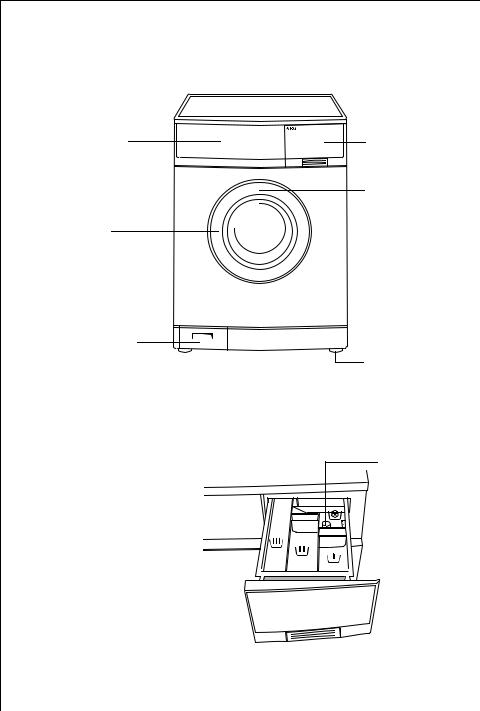
Operating instructions
Description of the appliance
Front view
Control panel
Fill-in door
Flap in front of circulation pump
Drawer for detergent and conditioner
k Pre-wash detergent/ detergent for soaking or water softener
l Main wash detergent (powder) and water softener if required
m Stain remover
w Liquid conditioner (softener, finisher, starch)
Drawer for detergent and conditioner
Rating plate (behind door)
Threaded feet (height adjustable); right rear: automatically adjusting foot
Suction cap (must be securely in place)
10
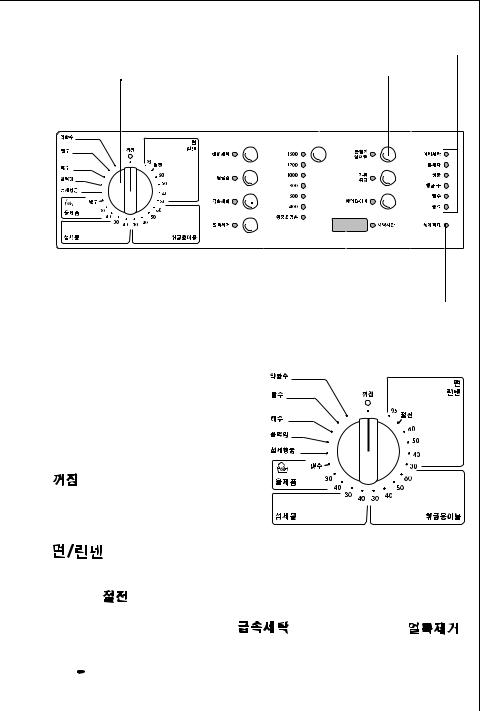
Operating instructions
Control Panel
|
Program Progress Display |
|
Program Selector |
DOOR/LIGHT Button |
|
Spin Speed/RINSE HOLD |
START/PAUSE |
|
Button |
|
Button |
|
|
|
|
|
|
|
|
|
|
|
|
|
|
|
|
|
|
|
|
|
|
|
|
|
|
|
|
|
|
|
|
|
|
|
|
|
|
|
|
|
|
Additional Program Buttons |
DELAY TIMER |
|||||
|
|
|
|
button |
||
|
|
|
|
|
|
|
Multi-Display OVERDOSING
Indicator
Program selector
The program selector defines the nature of the washing cycle (e.g. water level, drum movement, number of rinses, spin speed) to suit the type of washing, as well as the wash temperature.
(OFF)
Switches the washing machine off, the machine is switched on in all other positions.
(COTTONS/LINEN)
Main washing cycle for cottons/linen at 30 °C to 95 °C.
2 |
Position |
(ENERGY SAVING): Energy saving program at approx. |
|
|
67 °C for lightly to normally soiled cotton washing, extended washing |
||
|
time. Cannot be combined with |
(QUICK WASH) and |
|
|
(STAIN). |
|
|




 (EASY-CARES)
(EASY-CARES)
Main washing cycle for easy-care textiles at 30 °C to 60 °C.
11
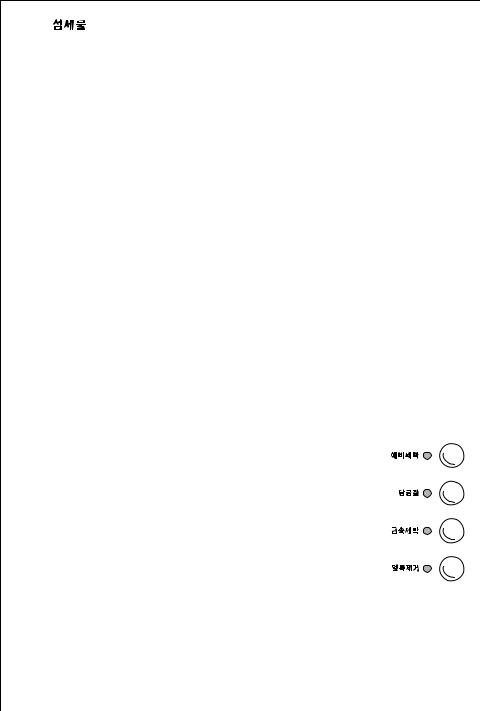
Operating instructions
(DELICATES)
Main washing cycle for delicates at 30 °C or 40 °C.


 /P (WOOLLENS/Hand Washing)
/P (WOOLLENS/Hand Washing)
Main washing cycle (
 /cold to 40 °C) for machine washable wool as well as for hand washable woollen fabrics and silk with the care symbol ï(Hand Washables).
/cold to 40 °C) for machine washable wool as well as for hand washable woollen fabrics and silk with the care symbol ï(Hand Washables).



 (GENTLE RINSE)
(GENTLE RINSE)
Separate gentle rinse, e.g. for rinsing hand washed textiles (2 rinse cycles and short spin).


 (STARCHING)
(STARCHING)
Separate starching, separate softening, separate conditioning of wet washing (1 rinse, liquid conditioner is washed in from the compartment w, and spinning).

 (PUMP OUT)
(PUMP OUT)
Pumping out the water after a rinse hold (without spinning).

 (SPIN)
(SPIN)
Pump out the water at the end of a rinse or a spin, or a separate spin of hand washed cotton/linen.

 (SHORT SPIN)
(SHORT SPIN)
Pump out the water at the end of a rinse and short spin, (easy-care washing, delicates, wool).
Additional Program Buttons
The additional program buttons are used to adapt the washing program to suit the degree of soiling of the washing. Additional programs are not required for normally soiled washing.
The different functions can be combined together depending on the program.




 (PRE WASH)
(PRE WASH)
Cold pre wash prior to the subsequent main washing cycle that follows automatically.


 (SOAKING)
(SOAKING)
Approx. 1 hour at 40 °C. Can be lengthened to a maximum of 19 hours using the 




 (DELAY TIMER) button. The main washing program then follows automatically.
(DELAY TIMER) button. The main washing program then follows automatically.


 (QUICK WASH)
(QUICK WASH)
Shortened main washing cycle for lightly soiled washing.
12
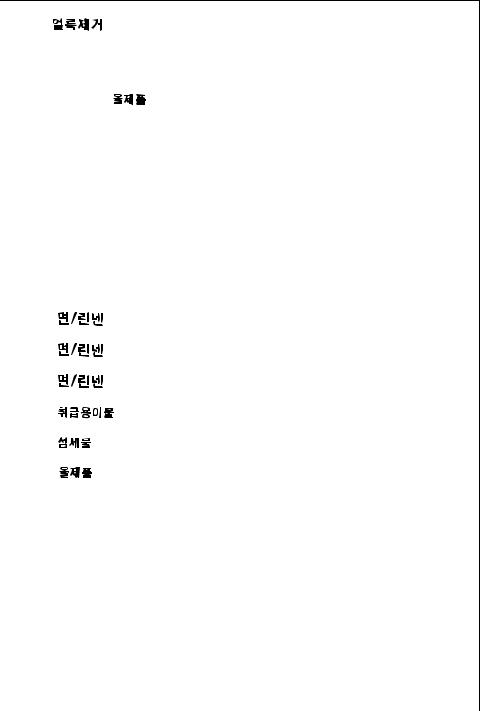
Operating instructions
(STAIN)
For treating heavily soiled or stained washing. (Stain remover is washed in from the m compartment at the optimal point in the program cycle.)
3 |
When the |
/ P(WOOLLENS/Hand washing) setting is chosen, the |
|
additional programs cannot be selected (any buttons pressed do not |
|
have any effect).
Consumption data and required time
The values for the selected programs in the following table have been determined under standard conditions. They provide a helpful orientation for operation in the home.
Program Selector/Temperature |
Max. Load |
Water |
Energy |
Time |
|
in kg |
in litre |
in kWh |
in minutes |
||
|
|||||
|
|
|
|
|
|
|
|
|
|
|
|
(COTTONS/LINEN) 95 |
5 |
39 |
1.65 |
133 |
|
|
|
|
|
|
|
(COTTONS/LINEN) 601) |
5 |
39 |
0.89 |
119 |
|
|
|
|
|
|
|
(COTTONS/LINEN) 40 |
5 |
39 |
0.55 |
113 |
|
|
|
|
|
|
|
(EASY-CARES) 40 |
2.5 |
42 |
0.42 |
84 |
|
|
|
|
|
|
|
(DELICATES) 30 |
2.5 |
49 |
0.40 |
64 |
|
|
|
|
|
|
|
/P |
2 |
39 |
0.20 |
36 |
|
(WOOLLENS/Hand Washing) 30 |
|||||
|
|
|
|
||
|
|
|
|
|
|
1) Note: program selection for testing per EN 60 456 |
|
|
|
||
13
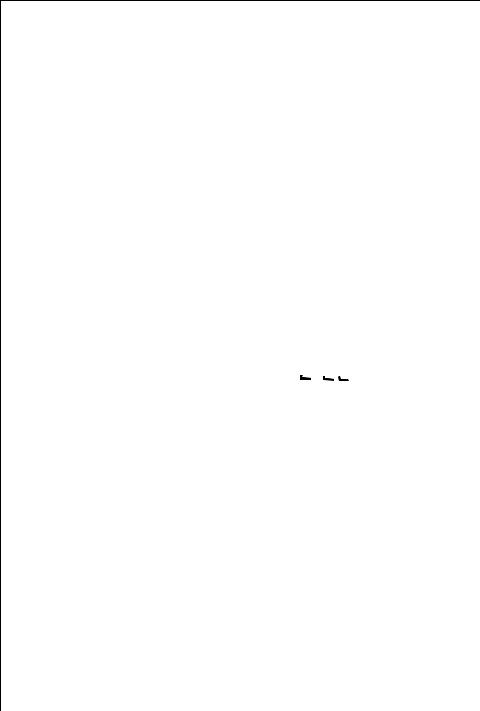
Operating instructions
What does "update" mean?
New fabrics or new detergents could, in the future, require a new washing technique (e. g. an additional rinse, more water to wash in the detergent, ...).
Your washing machine is prepared for this eventuality. The controller is fully electronic. The software in which the controller is defined can be re-programmed.
If a new state of the art is achieved in washing technology, you can bring your washing machine up to the latest standard with an update. For more information concerning updates, please contact customer service. Customer service can also inform you of the costs involved in an update..
Before washing the first time
0 1. Pull the detergent drawer a short distance out of the control panel.
2.Pour about 1 litre of water through the detergent drawer and into the washing machine. This is required in order to seal the wash-water container so that the ECO valve can function properly.
3.Run a washing cycle without any washing, 



 (COTTONS/LINEN) 95, with detergent quantity cut in half.
(COTTONS/LINEN) 95, with detergent quantity cut in half.
This serves to remove residues resulting from production of the appliance from the drum and the wash-water container.
14

Operating instructions
Prepare washing cycle
Sort washing and prepare
•Sort washing according to care symbol and type (see "Washing types and care symbols").
•Empty all pockets.
•Remove metal objects (paper clips, safety pins etc.).
•In order to prevent bunching up of washing and damage to washing, close zippers, button up duvets and pillow cases, and tie up loose ends from, for example, aprons.
•Turn articles with double layered textiles inside out (sleeping bags, anoraks etc.).
•Coloured, knitted fabrics, as well as wool and textiles with appliqués should be turned inside out.
•Place small and delicate articles (baby booties, stockings, bras etc.) into a washing net, a pillow case with zipper, or in large socks before washing.
•Treat net curtains particularly carefully. Remove metal curtain rail rollers or burred plastic rollers, or wrap these in a net or bag.
We cannot accept any liability for damage.
•Do not wash coloured and white washing together. White washing will otherwise turn grey.
•New, coloured washing often contains excessive dye. Wash these items separately the first time.
•Mix small and large articles of washing! This improves washing efficiency, and the washing is more favourably distributed during the spin cycle.
•Fluff washing before placing into the washing machine.
•Do not place folded washing into the drum.
•Observe tips for proper care such as "wash separately" and "wash separately several times"!.
15
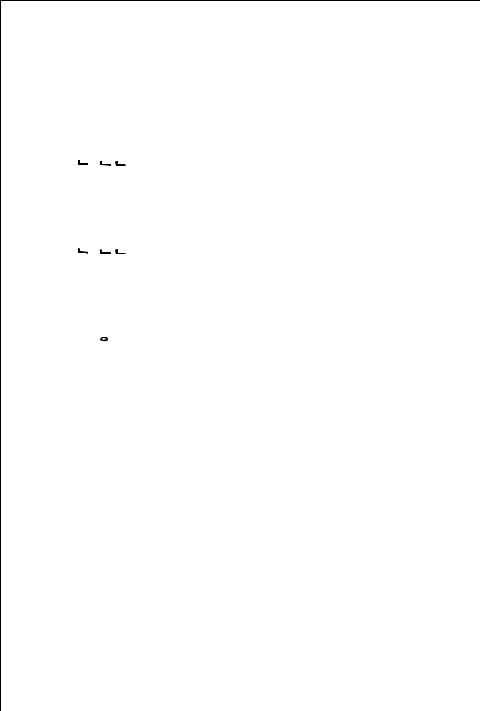
Operating instructions
Washing types and care symbols
Care symbols assist in the selection of the correct washing program. Washing should be sorted according to type and care symbol. The temperatures indicated in the care symbols are maximum temperatures.
Cottons ç
Textiles made from cotton and linen which bear this care symbol are insensitive to mechanical stress and high temperatures.
The 



 (COTTONS/LINEN) program is appropriate for this type of washing.
(COTTONS/LINEN) program is appropriate for this type of washing.
Linen è ë
Textiles made from cotton and linen which bear these care symbols are insensitive to mechanical stress.
The 



 (COTTONS/LINEN) program is appropriate for this type of washing.
(COTTONS/LINEN) program is appropriate for this type of washing.
Easy-care washing ê í î
Fabrics such as treated cottons, cotton mixtures and synthetics with this care symbol need to be handled carefully in machines.
The 




 (EASY-CARES) program is suitable for this type of washing.
(EASY-CARES) program is suitable for this type of washing.
Delicates ì
Fabrics such as those with layered fibres, micro-fibres, as well as synthetics and net curtains with this care symbol require particularly careful handling. The 

 (DELICATES) program is suitable for this type of washing.
(DELICATES) program is suitable for this type of washing.
Wool and particularly delicate washing 9 ì ï
Textiles such as wool, wool mixtures and silk which bear these care symbols are especially sensitive to mechanical stress.
The 

 /P (WOOLLENS/Hand washing) program is appropriate for this type of washing.
/P (WOOLLENS/Hand washing) program is appropriate for this type of washing.
Important! Fabrics with this care symbol ñ(Do Not Wash!) must not be washed in the washing machine!
16

Operating instructions
Detergent and conditioner
Which detergent and conditioner?
Use only detergents and conditioners which are suitable for use in washing machines. Always observe the manufacturer’s instructions.
How much detergent and conditioner?
The required quantity depends upon:
• the amount of washing
2 If the detergent manufacturer does not include dosing instructions for reduced loads, use one third less for half loads and only half of the full load detergent quantity for very small loads.
• extent of soiling of the washing
• hardness of tap water
Observe instructions for use and dosing provided by the detergent and conditioner manufacturer.
Using Water Softener
In the case of medium to very hard water (from hardness band II) water softener should be used. Observe the manufacturer’s instructions! Then always use detergent dosing for hardness band I (= soft). Information on the hardness of the water in your area is provided by your local water board.
2 |
Due to the fact that the water softener is added before the main wash |
||
|
detergent (pre-softening of the water), only eighty percent of the |
||
|
quantity of water softener indicated on the package is required. |
||
|
Information on Water Hardness |
|
|
|
|
|
|
|
Hardness Band |
Water hardness in °dH |
Water hardness in mmol/l |
|
(German hardness scale) |
(millimol per litre) |
|
|
|
||
|
|
|
|
|
|
|
|
|
I – soft |
0 – 7 |
to 1.3 |
|
|
|
|
|
II – medium-hard |
7 – 14 |
1.3 – 2.5 |
|
|
|
|
|
III – hard |
14 – 21 |
2.5 – 3.8 |
|
|
|
|
|
IV – very hard |
greater than 21 |
greater than 3.8 |
|
|
|
|
17
